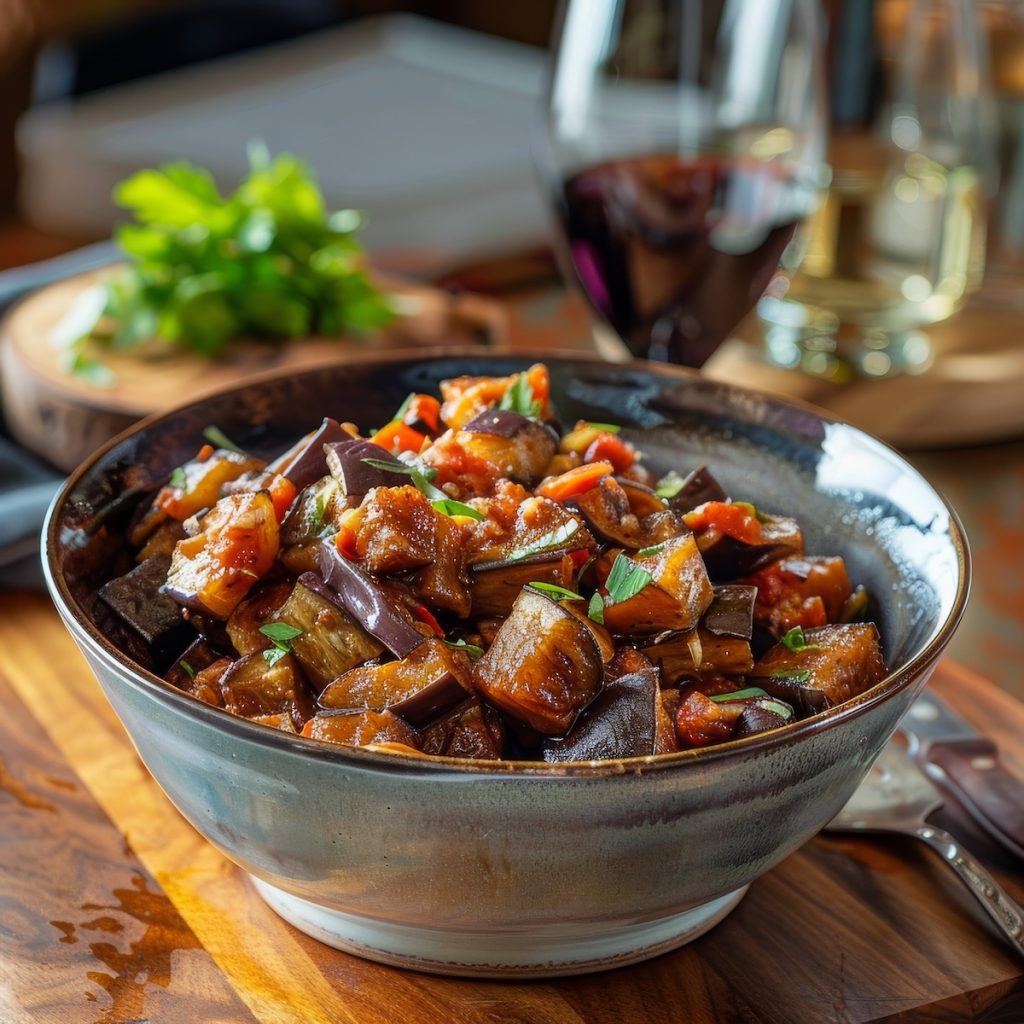Grilled Eggplant Caponata
This weekend my wife & I hosted a dinner party for some friends including our youngest daughter’s confirmation mentor. We wanted to prepare something special so my wife dug through some of my old Food & Wine mags and found this recipe for grilled eggplant caponata.
What is Caponata?
Grilled eggplant caponata is a vibrant, flavorful Sicilian dish that embodies the essence of Mediterranean cuisine. Traditionally, caponata is a cooked vegetable salad, primarily featuring eggplant and other vegetables like tomatoes, celery, and onions, all sautéed together in a sweet and sour sauce known as “agrodolce.” This dish is often enjoyed as an antipasto (starter), side dish, or even a main course, served either hot or at room temperature.
Grilling the eggplant before combining it with the other ingredients adds a smoky depth to the dish, enhancing its complexity. To prepare grilled eggplant caponata, start by slicing the eggplant into rounds or cubes, then sprinkle with salt and let it sit for about 30 minutes to draw out any bitterness. After rinsing and patting the slices dry, brush them with olive oil and grill until they are tender and have nice grill marks, usually about 4-5 minutes per side.
The other key components of caponata are onions, celery, tomatoes, capers, and olives, all cooked until tender. The sweet and sour flavor profile is achieved by adding a combination of vinegar (typically red wine vinegar) and a touch of sugar or honey. Some recipes might also include pine nuts or raisins for additional texture and sweetness.
Once the grilled eggplant is ready, it’s combined with the sautéed vegetables and simmered briefly to allow the flavors to meld. Fresh basil or parsley can be stirred in at the end for a burst of freshness.
Grilled eggplant caponata is a versatile dish that can be served in various ways. It pairs beautifully with crusty bread, making it a delightful bruschetta topping. It can also be spooned over pasta, used as a filling for sandwiches, or served alongside grilled fish or meats.
This dish not only highlights the flavors of each ingredient but also showcases the traditional Sicilian approach to cooking, where simple, high-quality ingredients are combined to create a harmonious and delectable dish.
Eggplant Caponata History
Eggplant caponata, a quintessential Sicilian dish, has a rich history that reflects the island’s diverse cultural influences and agricultural abundance. The origins of caponata can be traced back to the 9th century during the Arab rule in Sicily. The Arabs introduced many ingredients and culinary techniques to the region, including eggplants, which became a staple in Sicilian cuisine.
The name “caponata” itself likely derives from the Catalan word “caponada,” referring to a similar type of cooked vegetable salad. However, there are also theories suggesting the name might be related to “capon,” a type of fish often served with a sweet and sour sauce, with the vegetable version evolving as a more accessible and sustainable alternative for the masses.
Caponata’s key feature is its “agrodolce” (sweet and sour) flavor, a hallmark of Sicilian cooking that highlights the island’s historical trade connections and the blending of culinary traditions. This flavor profile was further refined with the introduction of tomatoes, which arrived in Europe from the Americas in the 16th century.
Originally, caponata was a humble dish, utilizing readily available ingredients. Eggplants, tomatoes, celery, onions, capers, and olives were common in Sicilian gardens, and the agrodolce sauce made from vinegar and sugar or honey was a way to preserve vegetables. The dish was versatile, served as a side, a main course, or even a condiment, demonstrating the resourcefulness of Sicilian cooks.
Throughout its history, caponata has evolved, with regional variations emerging across Sicily. Some versions might include pine nuts, raisins, or peppers, while others might feature different herbs and spices. Despite these variations, the essence of caponata remains the same: a celebration of fresh, local produce and the harmonious blend of sweet and sour flavors.
Today, eggplant caponata is enjoyed worldwide, appreciated for its rich history and its ability to capture the spirit of Sicilian cuisine. It serves as a delicious reminder of the island’s complex past and its enduring culinary traditions.
Grilled Eggplant Caponata Recipe
Ingredients
- ¼ cup pine nuts
- 2 eggplants 1 pound each, peeled and sliced lengthwise in 1/2-inch thick slices
- ¼ cup olive oil extra-virgin, extra for brushing
- salt and freshly ground pepper
- 1 large onion cut into ¼ inch dice
- 2 celery ribs cut into ¼ inch dice
- ¼ cup currants
- 1 teaspoon crushed red pepper more if you like it really hot, less if you don’t like hot at all
- 28 ounces crushed tomatoes
- ¼ cup sugar light brown
- ¼ cup balsamic vinegar
- ½ cup kalamata olives pitted, quartered
- ¼ cup chipped mint
Instructions
Toast the Pine Nuts
- You can toast them in a small frying pan on top of the stove or roast them in a preheated oven (350ºF) for about 4 minutes. They are done when they turn golden brown. Let them cool and reserve.
Grill the Eggplant
- Preheat your grill.
- While it is heating up, brush the eggplant slices with some of the extra olive oil then season with salt & pepper. Grill the eggplant over medium heat until tender. There may be some charring going on and that’s fine.
- Let the eggplant cool down and cut into ½ inch dice.
Cook, Combine & Serve
- Heat the ¼ cup of olive oil in a large skillet. Add the onion, celery, currants, crushed red pepper and reserved toasted pine nuts. Cook over medium heat until the onions and celery soften. Be sure to stir often so nothing burns. This should take about 10 minutes.
- Add the crushed tomatoes, light brown sugar and balsamic vinegar. Adjust the heat to bring the ingredients to a simmer. You want to cook this down for about 8 minutes until most of the liquids have evaporated.
- Add the diced eggplant and olives to the skillet. Stir to combine and season with salt and pepper to taste.
- Serve at room temperature with the chopped mint as a garnish.








